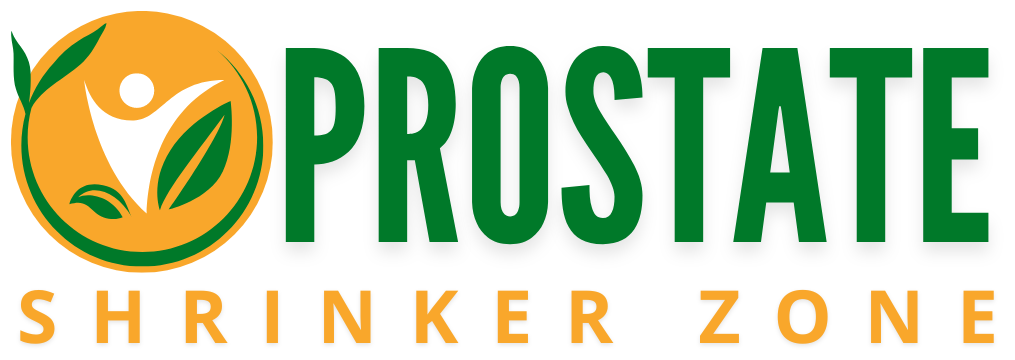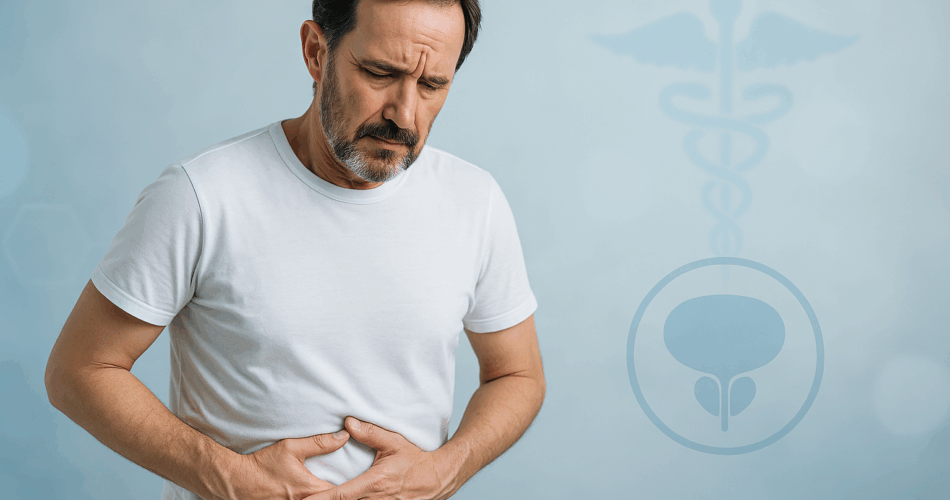Benign prostatic hyperplasia (BPH) is non-cancerous prostate enlargement that tends to progress with age. Two things are important:
- Prostate size: how much tissue has grown.
- Lower urinary tract symptoms (LUTS): frequency, urgency, weak stream, nocturia.
A larger prostate can create more obstruction; yet some small prostates cause severe symptoms while some large ones cause few. Daily habits can nudge biology toward faster growth (inflammation, hormonal signaling, metabolic dysfunction) and can also worsen symptoms by irritating the bladder or tightening surrounding muscle tone.
Bottom line: the habits below may fuel enlargement pathways or aggravate obstruction. Adjusting them helps reduce risk and ease symptoms.
How Daily Habits Drive Faster Enlargement
Think of the prostate like a small factory responding to signals. Inflammation, insulin, androgens, and vascular health act like dials. Sedentary life, ultra-processed diets, disordered sleep, chronic stress, smoking, and certain medicines can twist those dials upward.
The following ten habits are the stealthy culprits—and what to do about each.
Habit #1—Chronic Sitting and Low Movement
Why it may accelerate enlargement
Long sitting reduces pelvic blood flow and is associated with higher systemic inflammation. Lower circulation plus higher inflammatory signaling can encourage glandular growth and worsen urinary discomfort.
What to do instead
- Insert movement snacks: 10 minutes of brisk walking, three times per day.
- Use a standing desk or set a 50/10 timer (50 minutes work, 10 minutes moving).
- Add pelvic mobility drills (hip flexor stretches, gentle squats).
Pros & Cons
- Pros
- Improves circulation and energy.
- Helps weight management and insulin sensitivity.
- May reduce stiffness and pelvic pressure.
- Cons
- Requires schedule discipline.
- Initial soreness if deconditioned.
Habit #2—Ultra-Processed, High-Fat Diet (with Low Fiber)
Why it may accelerate enlargement
Ultra-processed foods (UPFs) often combine refined carbs, unhealthy fats, low fiber, and additives—conditions linked to insulin resistance and chronic low-grade inflammation, two drivers that can upregulate growth signals relevant to BPH.
What to do instead
- Build a whole-food baseline: vegetables, legumes, intact grains (if tolerated), fish, lean proteins, nuts, olive oil, herbs/spices.
- Aim for 25–35 g fiber/day; include omega-3 sources (fatty fish, flax, chia).
- Use plate sequencing: protein + fiber + fat before starch to blunt glucose spikes.
Pros & Cons
- Pros
- Supports metabolic health and healthy weight.
- May reduce systemic inflammation.
- Improves satiety and energy stability.
- Cons
- Meal prep time and learning curve.
- Eating out may require planning.
Habit #3—Nighttime Fluid Bomb (Late Water, Caffeine, Alcohol)
Why it may accelerate enlargement/symptoms
Large fluid loads late in the evening, especially caffeine and alcohol, increase urine production and bladder stimulation, aggravating nocturia and urgency. Chronic sleep disruption feeds back into hormonal and inflammatory pathways.
What to do instead
- Front-load hydration earlier in the day; taper after 6 pm.
- Avoid caffeine after 2 pm; limit alcohol and spicy/acidic irritants at night.
- Create a wind-down routine with a warm shower and dim light.
Pros & Cons
- Pros
- Fewer night trips, better sleep quality.
- Less bladder irritation.
- Cons
- Social routines may need tweaks.
- Early hydration requires habit change.
Habit #4—Ignoring Metabolic Health (Insulin Resistance & Central Obesity)
Why it may accelerate enlargement
Insulin and IGF-1 signaling intersect with cellular growth pathways. Central adiposity raises inflammatory cytokines and can alter hormone balance, potentially speeding prostate tissue growth.
What to do instead
- Resistance training 2–3×/week (major muscle groups).
- Carb quality & sequence: prioritize fiber/protein; reserve starches post-exercise.
- Track waist circumference, fasting glucose/A1C with clinician guidance.
Pros & Cons
- Pros
- Improves insulin sensitivity and body composition.
- Broad cardiovascular benefits.
- Cons
- Gym access or weights needed (or bodyweight alternatives).
- Progress is gradual; requires consistency.
Habit #5—Unmanaged Sleep Apnea & Poor Sleep Hygiene
Why it may accelerate enlargement
Sleep apnea and fragmented sleep elevate sympathetic tone, cortisol, and systemic inflammation. Hormonal misalignment can intensify growth signals and exacerbate urinary symptoms.
What to do instead
- Screen for apnea (snoring, witnessed pauses, morning headaches).
- Consider a sleep study; adhere to CPAP if prescribed.
- Standardize sleep/wake times; limit screens 60 minutes before bed.
Pros & Cons
- Pros
- Better energy, mood, and nighttime urination patterns.
- Downshifts inflammatory signaling.
- Cons
- CPAP acclimation can be challenging.
- Evening routine changes required.
Habit #6—High, Unrelieved Stress (Cortisol Overdrive)
Why it may accelerate enlargement
Chronic stress sustains elevated cortisol and sympathetic output, which are associated with immune imbalance and inflammation—conditions that can nudge the prostate toward growth and heighten pelvic floor tension.
What to do instead
- 10-minute daily breathwork (box breathing 4-4-4-4).
- Nature breaks or sunlight walks at lunch.
- Progressive muscle relaxation or short guided meditations.
Pros & Cons
- Pros
- Rapid, low-cost stress relief.
- Improves sleep and perceived urinary comfort.
- Cons
- Benefits are “invisible” at first; easy to skip.
- Requires consistency to compound.
Habit #7—Smoking and Vaping Toxicants
Why it may accelerate enlargement
Cigarette smoke and many vape aerosols contain oxidants and toxins that impair vascular function and raise oxidative stress. Poor circulation plus inflammation is an unfavorable milieu for prostate health.
What to do instead
- Plan a cessation date; explore nicotine replacement and behavioral support.
- Replace triggers (after-meal smoke) with 2-minute movement or mint tea.
- Track streaks; reward milestones.
Pros & Cons
- Pros
- Broad health improvements (vascular, lung, sexual function).
- Reduced inflammatory burden.
- Cons
- Withdrawal symptoms; relapse risk.
- Strong habit loops to unwind.
Habit #8—Misuse of Decongestants & Anticholinergics
Why it may accelerate enlargement/worsen symptoms
Some decongestants (alpha-agonists) and anticholinergic agents can tighten the bladder neck or reduce bladder contractions, worsening urinary retention—especially in men with underlying enlargement.
What to do instead
- Use saline nasal rinses, steam, or topical menthol as non-drug aids.
- Discuss alternatives with a clinician, especially if weak stream/retention exists.
- Keep an updated med list; review at each appointment.
Pros & Cons
- Pros
- May ease urinary flow and reduce retention risk.
- Encourages safer, individualized care.
- Cons
- Cold/allergy relief may be slower without strong decongestants.
- Requires coordination with healthcare providers.
Habit #9—“Holding It” (Bladder Overdistension)
Why it may accelerate enlargement/worsen obstruction
Regularly delaying urination can overstretch the bladder, increase intravesical pressure, and aggravate bladder outlet obstruction when the prostate is already enlarged or irritable.
What to do instead
- Adopt timed voiding every 2–3 hours during the day.
- Double voiding at bedtime (urinate, relax, try again).
- Keep routes to restrooms easy and stress-free.
Pros & Cons
- Pros
- Reduces urgency, improves emptying.
- Supports healthier bladder habits.
- Cons
- Requires planning during long meetings or travel.
- May feel inconvenient initially.
Habit #10—Skipping Preventive Checkups
Why it may accelerate enlargement risks
Avoiding checkups can delay detection of meaningful progression or co-conditions (e.g., infections, stones, elevated PSA requiring evaluation). Early action typically means simpler action.
What to do instead
- Schedule an annual visit; discuss urinary symptoms, family history, and PSA screening via shared decision-making.
- Track voiding patterns (frequency, urgency, nocturia) with a simple log.
Pros & Cons
- Pros
- Enables earlier, less intensive interventions.
- Monitors trends rather than reacting to crises.
- Cons
- Time and cost considerations.
- May prompt additional tests if findings are unclear.
One-Week Reset Plan (Prostate Shrinker Zone Style)
A simple, repeatable protocol to lower irritation and support better urinary comfort—suitable for most adults. For education only.
Day-by-Day Checklist
- Day 1 (Baseline & Setup)
- Track beverages and urinations for 24 hours.
- Remove evening caffeine and alcohol.
- 2× 10-minute walks.
- Day 2 (Hydration Timing + Movement)
- 70–80% of daily fluids before 4 pm.
- Add a third 10-minute walk; introduce hip flexor stretches.
- Day 3 (Food Quality & Sequencing)
- Each meal: protein + fiber + healthy fat first, starch last.
- 25–35 g fiber target; add leafy greens and berries.
- Day 4 (Sleep Upgrade)
- Lights-down ritual 60 minutes pre-bed; cool, dark bedroom.
- Screen for snoring; note apnea risk and discuss with clinician if present.
- Day 5 (Stress Release)
- 10 minutes breathwork + 10 minutes nature walk.
- Timed voiding every 2–3 hours.
- Day 6 (Medication Review)
- List all OTC/Rx meds; flag decongestants/anticholinergics for discussion.
- Consider saline rinse/steam as alternatives for congestion.
- Day 7 (Reflect & Plan)
- Compare night-wakings, urgency, and comfort to Day 1.
- Book checkup if symptoms are moderate-to-severe or persist.
Mini Buyer’s Guide: Tools & Trackers
- Standing desk riser: supports sit-stand cycles.
- Water bottle with time marks: front-loads hydration.
- Resistance bands/dumbbells: quick strength sessions.
- Sleep mask/white-noise app: sleep consolidation.
- Habit tracker app: streaks for walks, breathwork, hydration timing.
Myths vs. Facts (Quick Clarity)
Myth: “Only old age causes enlargement.”
Fact: Age is a strong factor, but metabolic health, inflammation, sleep, and medications also matter.
Myth: “Drinking lots at night ‘flushes’ the prostate.”
Fact: Late fluids typically increase nocturia and irritability; hydrating earlier is smarter.
Myth: “If the stream is weak, just wait—it will pass.”
Fact: Persistent changes warrant evaluation to prevent complications.
Wrap-Up—A Smarter Way Forward (Not Just ‘Less, Later’)
Everyday behaviors can either pour fuel on the fire of prostate growth—or take oxygen away from it. Movement, whole-food nutrition, smart hydration timing, restored sleep, stress relief, toxin avoidance, medication awareness, healthy voiding patterns, and routine checkups collectively turn down the biologic dials that push enlargement and symptoms. Small, consistent shifts beat heroic, short-lived efforts.
Remember: This guide is educational. Individuals should seek professional assessment for diagnosis, screening, and treatment decisions.
FAQs
1) Does fixing habits actually shrink an already enlarged prostate?
Lifestyle improvements primarily reduce irritation and symptom burden and may slow progression. Dramatic “shrinking” typically requires medical therapy or procedures, which are determined by a clinician after evaluation.
2) How quickly can nighttime urination improve with changes?
Some people notice improvement within a week after cutting evening irritants and front-loading fluids. Others require a few weeks plus sleep and stress upgrades.
3) Are supplements necessary for prostate comfort?
Some individuals discuss options such as beta-sitosterol or saw palmetto with clinicians, but responses vary. Evidence and quality control differ; professional guidance is recommended.
4) When should someone seek urgent care?
Acute urinary retention, fever with urinary pain, blood in urine, or severe lower abdominal pain require prompt medical attention.
5) Can cardio alone replace resistance training?
Both help. Resistance training is particularly valuable for insulin sensitivity and hormonal balance. A blend—cardio + strength—is generally more effective for metabolic and vascular health.





